Twitter is like heaven on earth for penny stock promoters.
Back when most promoters used email, they had to have a disclaimer at the bottom.
But tweets don’t have enough room for a disclaimer…
Which means promoters can pump stocks as much as they want. Over the summer, they did just that. But I’m getting worried … the promoters might not be getting enough vitamins.
Table of Contents
- 0.1 Those Are Rookie Numbers
- 0.2 Stock Promoter Call to Action: Give Us 100 Tweets a Day
- 0.3 Press Release Pump City
- 0.4 Conspiracy Theory 101
- 1 What Do These Stocks Have In Common?
- 2 Why I Battle With Promoters and Newbies
- 3 Why I Donate My Trading Profits to Charity
- 4 Untradeable!
- 5 How to Overcome Promoter-Induced Blindness
- 6 30-Day Bootcamp
- 7 Trading Challenge
Those Are Rookie Numbers
The stock promoters have slowed down with the tweets. Some tweet as little as 20–30 times per day now. I don’t know if the promoters got sick because they’re not eating right or not getting enough sun. Whatever the reason, we need to do something to encourage more healthy promoters.
At the same time, it’s my job to teach you about promoted penny stocks. So while I try to get the promoters back in shape, I also want to educate you by…
Exposing Corruption in the Penny Stock Market
By the time you finish reading this post, you’ll better understand how to spot the pump. And I hope you’ll have compassion for the promoters who may have a vitamin D or B12 deficiency. If you know one or know someone who knows one … send an edible arrangement.
Let’s make promoters great again. We still have a few months left in 2020, and I want to donate more trading profits to charity. And that means we need promoters to do better!
Stock Promoter Call to Action: Give Us 100 Tweets a Day
The best promoters tweet about one stock 70–100 times a day. We saw promoters tweet about some stocks up to 200 times a day during the summer. They look like this…
“$IDEX going to the moon.”
“Whatever you do, hold $GNUS. Just wait until the weak hands get shaken out.”
“$MVIS investors … we eat short sellers for breakfast…”
“$NKLA Only the weak sell.”
“Who were the pansies who panic sold $RKT last week?”
“$MARK together we can make this happen!”
You get the idea. These promoters lure in newbies and Robinhooders, then sell into strength. What they’re doing isn’t necessarily illegal. But you’ll see me call them out on Twitter as I try to teach newbie traders how to protect themselves.
Thankfully looks like a disaster day for $PPSI $OPTT $PECK $WWR which are long overdue for corrections so recognize this is EXACTLY how hot sectors have always worked & don't listen to BS promoters who say "only the weak sell"…NO, only the weak don't take profits into strength!
— Timothy Sykes (@timothysykes) October 8, 2020
More Breaking News
- Is Biohaven’s Latest Innovation Reshaping the Pharmaceutical Terrain?
- SoFi Technologies Faces Uncertain Future After Downgrade
- Richtech Robotics Stock Soars: Analyzing the Surge Before CES 2025 Event!
Press Release Pump City
It’s not only promoters on Twitter pumping up stocks. Some companies pump their stocks with a barrage of press releases, too. But the end result is the same … The stock gets pumped and the price spikes.
Then someone, somewhere, sells into strength. Or the company dilutes shareholders…
Genius Brands International (NASDAQ: GNUS)
GNUS is a good example. Genius Networks put out a whole series of press releases about its new Kartoon Channel. It hyped up how Arnold Schwarzeneggar was involved. And it hyped how many cartoons it had lined up.
Check out the GNUS six-month chart:
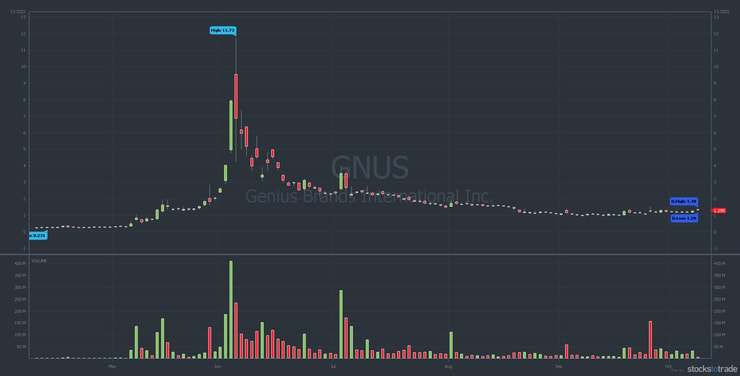
Guess what? The reason the stock is tanking every day is because Genius doubled its number of shares. The company diluted everybody. The CEO doesn’t talk about that in his press releases.
Conspiracy Theory 101
Promoters love to take credit on the way up. But on the way down they say, “How dare you listen to me. I’m not responsible for your trading.”
Newbies blame short sellers and conspiracy theories. They want to believe in the company and its products. So they fall for the rumors and hype. And they get SO MUCH hype … from the ‘free’ chat room guru to the Twitter pumper or company press release. Then they join together and become a community.
As it turns out, with most of these companies the rumors aren’t true. You can’t EVER believe in them. Same with the plays. Ride the hype up, just never believe it. I know you don’t want to be cynical. Be cynical. (I’m overly cynical … but that’s because I’ve been at this game for 20 years.)
So when the community’s stock starts to tank, they call it a conspiracy…
First, it’s the short sellers. They actually think I’m he started tracking everything. He figured out what was working for him. As it turns out, it was only two patterns. He’d tried short selling. They don’t realize I show all my trades and don’t short sell anymore. It’s not worth it for me as a teacher and it’s not worth it for newbie traders. It’s a terrible strategy right now that’s very crowded.
Once they realize I don’t short sell, they think I’m somehow trying to tank the stock so that I can dip buy.
I’m not shorting. And I’m not trying to tank these stocks. I want these stocks as high as possible. But it’s my job to teach, OK?
The question you should be asking is…
What Do These Stocks Have In Common?

One thing they have in common is that the patterns are similar. It’s clear where they start getting promoted and where the rug gets pulled out from under them. But that’s not the answer to the question.
The answer is simple: They’re all promoted stocks.
Along the way, they might get pumped on Twitter or in press releases. They might show up in so-called free chat rooms. But however it’s happening, they’re getting pumped. It blows my mind how often people still think it’s down to fundamentals…
Booming Business or Promoted Stock?
You can hype up the story and pump up the stock price, but deep down there’s an actual business. And the business requires cash. A lot of these companies don’t have it. So, the stock gets promoted.
Here’s an example of a booming business that missed on earnings…
Rocket Companies, Inc. (NYSE: RKT)
First, I tweet about a stock like RKT tanking after earnings. Then the promoters or newbies who believe in the company say, “No way, they BEAT earnings estimates.”
It doesn’t matter.
A bad reaction to earnings is what matters. If the stock tanks, that’s NOT an earnings winner. Thinking otherwise might be a good new definition of insanity.
Check out the RKT three-month chart:

On RKT, I didn’t even trade it. But people who did were asking me what to do. Always follow rule #1: cut losses quickly. For me, it would’ve been easy. If I was in an earnings ‘winner’ that started tanking, I’d follow rule #1. Pretty much every successful trader I know has the same rule #1.
What pissed me off with RKT was the promoters saying, “RKT’s fundamentals are perfect. Only the weak sell. This dip is a short seller manipulation scheme.” Which is crazy. It lures newbies into tweeting things like … “This company is going places.”
Why I Battle With Promoters and Newbies

I don’t want to curse the promoters in the game right now. And I don’t want to expose them. Many people ask why I don’t name them. They never use their real names in the first place. And when they get exposed they just change their screen name.
Whack-a-Promoter?
So I don’t like playing whack-a-mole and trying to find the promoters’ new names. Let’s just let the promoters do their thing.
Without the lack of serious competition, the promoters & short sellers battling & now the dumb AF Robinhooders joining in to create even more volatility, LOL, well now you can see why this is such a record year for those with any experience in this niche, let the good times roll!
— Timothy Sykes (@timothysykes) October 7, 2020
And…
I’m Not a Lawyer
I’m not trying to shut them down. And I’m not saying this is illegal. I don’t even know. Whether or not they go to jail — I don’t care. I just want more promos.
Again, Twitter promoters don’t use disclaimers. So who knows how many shares they have? They don’t share their position sizes OR their real names. That’s another reason why I share actual position sizes with my real name.
The same goes for all my top students. This differentiates us from pretty much everyone else on social media. And these financial communities are tweeting and posting to get you to follow them. Why? Because it’s in their own best interest.
When they tweet 10, 20, or 50 times about a stock in a day, it’s obvious. We get it. Anybody with a brain gets it. If you tweet once or twice about a stock and say, “I’m long this stock.” OK, I know you’re long … I know you want it to go up.
But the reason they tweet it so many times is because they’re trying to lure in more people. They post photographs, press releases, and websites. And they supposedly email or talk with investor relations.
It’s all just to keep the pump going to get the stock as high as possible. That’s the point of promos.
Why I Donate My Trading Profits to Charity

Part of the reason I donate 100% of my trading profits to charity is that it brings me great pleasure. Yes, I like donating to charity. I donate my own personal money. It’s my honor to donate over a million dollars every year for the past few years to different charities.
So that’s cool. But…
Teaching Students Is My Priority
By donating all my trading profits, it removes the temptation to trade for my own personal gain. It helps me to focus on setups I know students can learn. It makes no personal difference to me whether I win or lose on a trade. I think it makes me a better, unbiased commentator. It means I can give you more honest and helpful commentary.
So when I point out promoted stocks on social media, it’s because we’re seeing the…
Same Game Played Again and Again
It’s laughable. It was the same in 2014 when I exposed the pot stock promoters. I linked to that article all summer long. And I warned everybody what would happen with all these pumps because it’s the same game.
But newbies resist anything that doesn’t match their confirmation bias. They said things like “Why are you talking to me about pot stocks? We’re talking about coronavirus. Have you lost your mind?”
The virus, the stock … it doesn’t matter. The stories don’t matter. It’s probably the same promoters, and they’ve just changed their screen names. It’s the same game played over and over again.
And I feel like I’m taking freakin’ crazy pills because it’s also the…
Same Exact Patterns
Those pot stocks dropped 99% after the pumps died. Now all the coronavirus stocks, the hot summer stocks … they’ve dropped 70%, 80%, even up to 90%. A few newbies listened. Some recognized it. But others just went down with the ship.
Untradeable!
I hope the promoters get their act together. We need them to do a better job because without them, some of these stocks are untradeable. Again, I don’t like short selling anymore. But I do love dip buying. And unless the stocks get promoted enough, it makes dip buying tough.
So come on promoters … do us a solid.
Everything Comes Down to the Promoters
We want more 10 or 15 times runups like…
Remark Holdings, Inc. (NASDAQ: MARK)
Check out the MARK six-month chart…
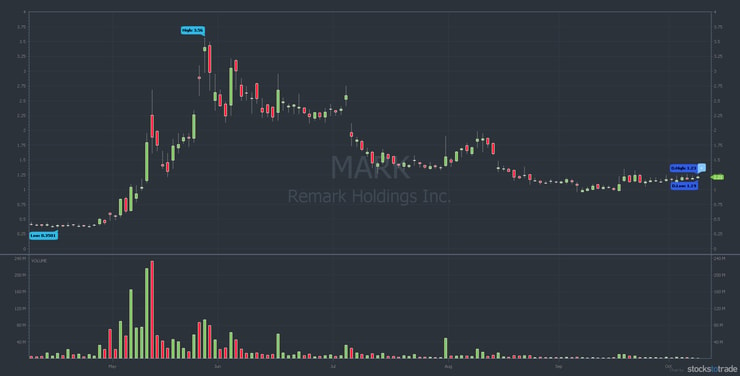
Another example is…
AgEagle Aerial Systems, Inc. (NASDAQ: UAVS)
Here’s the UAVS six-month chart…
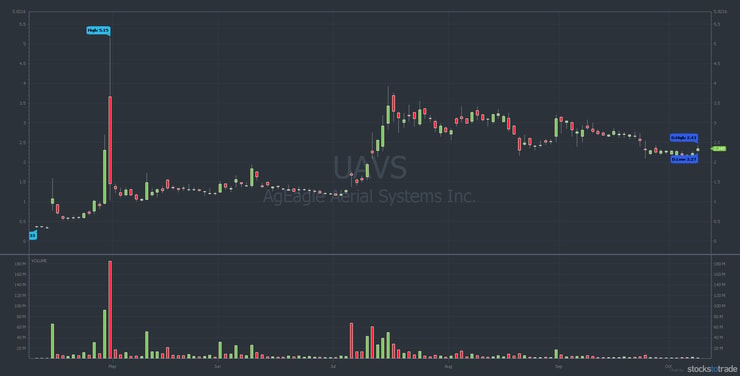
As you can see, the stock promoters did a good job pumping MARK and UAVS. So, now that things are slowing down a little, we need better promoters. You can help me. I know this might seem funny, but I mean it…
If you know a stock promoter, send them an edible arrangement. If you’re a promoter, send me your address. I’ll send you an edible arrangement. Maybe that will make you more effective.
I want the best plays for my students, and I want to make the most for charity. So we need more volatility. I think if we work together we can make this happen. (Yes, that was meant to be tongue in cheek.)
How to Overcome Promoter-Induced Blindness
This is gonna be easy but controversial at the same time. Ready? Good. This is how to overcome stock promoter induced blindness…
Look at the Chart
Crazy, right? Let’s do it. All these stocks got promoted. Every single one. As much as people want to say it’s from their booming business … it’s not. It’s because of promoters.
Nikola Corporation (NASDAQ: NKLA)
Here’s the NKLA six-month chart:
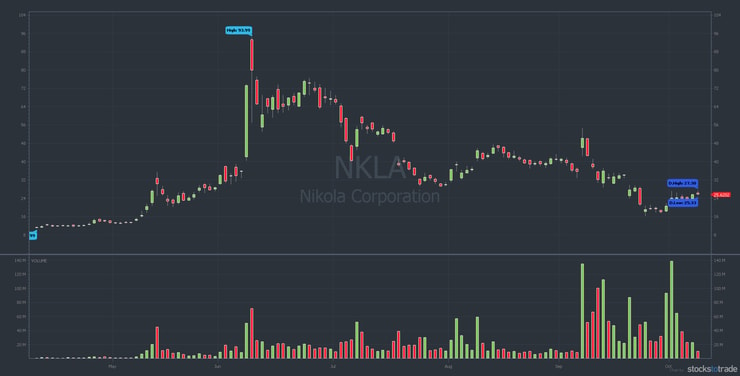
The NKLA six-month chart shows a crazy run-up before the smokescreen lifted. Here’s another example…
MicroVision, Inc (NASDAQ: MVIS)
Check out the MVIS six-month chart:
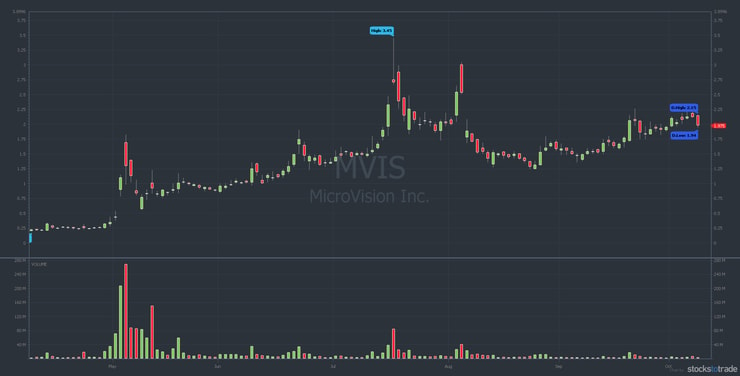
MVIS has managed to hold up better than most stocks getting pumped by stock promoters. But I wouldn’t trust it.
Here’s one more to drive it home…
Ideanomics, inc. (NASDAQ: IDEX)
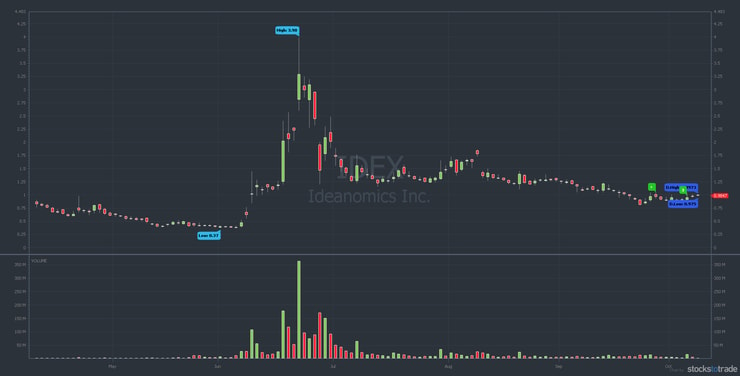
Do you see the similarities in ALL the charts in this post? After the pump, they all tanked. Sadly, too many of the promoters seem to be on vacation. (Or they lost their credibility.)
Retweet/favorite this if you want a video lesson on promoters failed on $DSGT $ENZC $NSPX $ALYI $FPVD & all those stocks are extra-junk today. It really is sad, all the promoters from the summer pumping shit like $IDEX $GNUS $MARK $XSPA $BOXL $ZOM have lost all their credibility
— Timothy Sykes (@timothysykes) October 12, 2020
I’ve been in this game for 20+ years. I’ve seen so many liars, so much hype, and so many promoters that nothing surprises me. But that doesn’t mean I want it to end. (I don’t.) Promoters help create volatility.
That’s why I’m so…
Grateful for the Stock Promoters
You should be grateful for stock promoters, too. Just don’t believe the BS.
To the promoters…
If you get paid in cash or stock…
… if you take big positions right before you tweet 20 times…
… you’ve pretty much sold your soul to the devil. What’s done is done.
But I'm truly grateful for the ignorance surrounding penny stocks, the biggest traders I know ignore them (not enough profit potential), short sellers believe these plays will go to zero (which create giant short squeezes) & promoters lure in the naive (which creates huge spikes)
— Timothy Sykes (@timothysykes) October 7, 2020
It sucks there are people like that — scumbags with no ethics. But they’ve made their choice in life. They’re not gonna be honest or transparent. So at least they can create good pumps for us honest traders.
I'm always grateful for all the lying piece of shit promoters out there who help creates these big spikes & the miserable over-aggressive short sellers who have created some awesome short squeezes lately, but don't listen to the "to the moon" or "it's going to zero" BS they spew!
— Timothy Sykes (@timothysykes) October 8, 2020
How to Recognize a Pump
The big tipoff sign is the promoters. And stock promoters don’t trade by rules. They don’t have rules because they’re not real traders. They’ve never had much success outside of tweeting 50 or 100 times a day and selling into the buyers they create. They don’t know the actual rules.
Now that you understand more about how to spot the promoters, it’s time to build your knowledge base. It’s time to develop the skills of a self-sufficient trader. How?
Start with the…
30-Day Bootcamp
The 30-Day Bootcamp is my most highly rated course ever. And I can’t take all the responsibility. Matt Monaco, who’s now passed $360,000 in profits, organized it.* He helped put it together. All you have to do is check out the Bootcamp Twitter feed to see how much students love it.
(*These results are not typical. Individual results will vary. Most traders lose money. My top students have the benefit of many years of hard work and dedication. Trading is inherently risky. Always do your due diligence and never risk more than you can afford to lose.)
If you’ve already completed the 30-Day Bootcamp and you’re ready to take the next step…
Trading Challenge
The Trading Challenge is everything I’ve learned in 20 years of trading. From 12 years of teaching, I have thousands of video lessons. You can build your foundation by watching hundreds of hours of DVDs. You’ll learn my process by watching the archived webinars. Each week you get two to four live webinars. Plus, I make daily watchlists. It’s epic. Apply for the Trading Challenge today.
Do you like posts like this exposing stock promoters and corruption? If you want more, let me know in the comments below. I love to hear from all my readers!
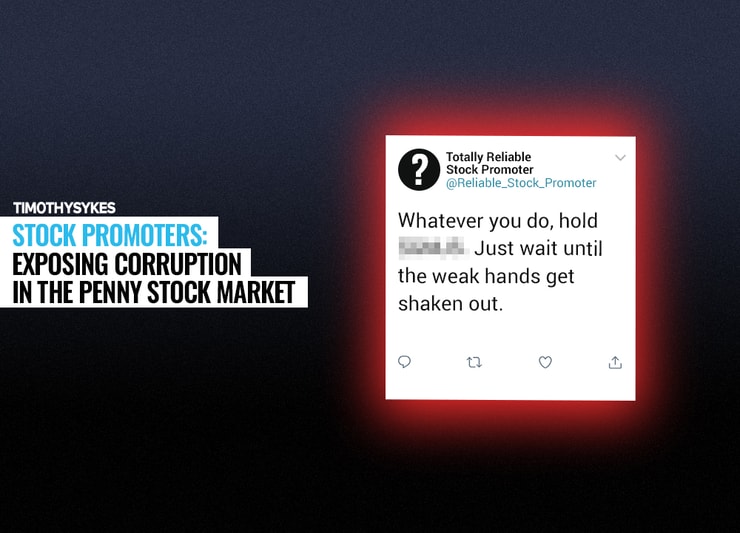


Leave a reply